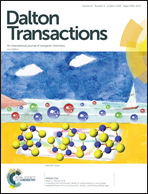Enhanced glucose sensing based on a novel composite CoII-MOF/Acb modified electrode†
Abstract
In this work, we demonstrate the synthesis and application of a novel CoII-based metal–organic framework {[Co2(Dcpp)(Bpe)0.5 (H2O)(μ2-H2O)]·(Bpe)0.5}n (CoII-MOF, H4Dcpp = 4,5-bis(4′-carboxylphenyl)-phthalic acid, Bpe = 1,2-bis(4-pyridyl)ethane) as an electrochemical sensor for glucose detection. Single-crystal X-ray diffraction analysis shows that the CoII-MOF has a two-dimensional (2D) bilayer structure composed of Co2 units and Dcpp4− ligands. There are two kinds of Bpe in the structure: one serves as a bidentate ligand linking two Co1 atoms in each 2D layer; the other is just free in the lattice. The CoII-MOF modified glassy carbon electrode (GCE) shows good electrocatalytic activity towards glucose oxidation. To further improve the catalytic activity of the electrode, a new composite of CoII-MOF/acetylene black (CoII-MOF/Acb) was constructed. The CoII-MOF/Acb modified electrode exhibits enhanced sensing behavior for glucose detection. The sensing performance of CoII-MOF/Acb/GCE with different Acb loadings was investigated in detail. The results demonstrate that CoII-MOF/GCE with 2% Acb (CoII-MOF/Acb-2%/GCE) exhibits the best sensing behavior, including a high sensitivity of 0.255 μA μM−1 cm−2 and a wide linear range of 5–1000 μM, as well as a low detection limit of 1.7 μM (S/N = 3). It's worth noting that the linear range of CoII-MOF/Acb-2%/GCE was extended by more than ten times when compared to that of CoII-MOF/GCE without Acb addition. In addition, CoII-MOF/Acb-2%/GCE shows good selectivity and stability in the sensing process.



 Please wait while we load your content...
Please wait while we load your content...